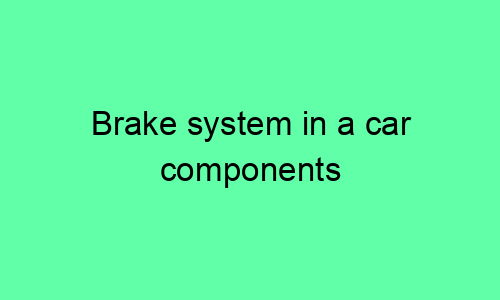## Brake System in a Car: Comprehensive Overview of Components and Functions
### Introduction
The brake system is a crucial safety feature in every automobile, responsible for decelerating and stopping the vehicle in a controlled and timely manner. It comprises various interconnected components that work in unison to convert the driver’s foot pressure on the brake pedal into braking force. This comprehensive guide will delve into the inner workings of the brake system, exploring its key components and their functions.
### Master Cylinder and Brake Lines
The master cylinder is the heart of the brake system. When the driver applies pressure to the brake pedal, it pushes a piston within the master cylinder, which in turn pressurizes brake fluid. This pressurized brake fluid is then distributed to the brake lines, which are flexible hoses or rigid tubes that convey the fluid to the wheels.
### Brake Calipers and Wheel Cylinders
Brake calipers are hydraulically actuated devices that clamp down on the brake rotor (disc) at each wheel. When brake fluid enters the caliper, it activates pistons that push brake pads against the rotor. The friction between the pads and the rotor generates the stopping force.
In older vehicles, wheel cylinders are used instead of calipers. They are hydraulically actuated drums that push brake shoes outward against the brake drum (a rotating metal cylinder), creating friction and slowing down the wheel.
### Brake Pads and Rotors/Drums
Brake pads are the consumable components that make direct contact with the brake rotor or drum. They are made of a friction material that provides the gripping force necessary for stopping the vehicle. As the brake pads wear down, they need to be replaced to maintain optimal braking performance.
Brake rotors and drums are the components that the brake pads or shoes act against to generate friction. Rotors are typically made of cast iron and are mounted to the wheel hub. Drums are also made of cast iron and are attached to the inside of the wheel.
### Brake Fluid
Brake fluid is a specialized hydraulic fluid that transmits pressure from the master cylinder to the brake calipers or wheel cylinders. It is essential for the proper functioning of the brake system. Brake fluid absorbs moisture over time, which can affect its performance, so it should be flushed and replaced periodically.
### Brake Booster
A brake booster is a device that amplifies the driver’s foot pressure applied to the brake pedal. This makes it easier for the driver to bring the vehicle to a stop, especially in emergency situations. There are two main types of brake boosters: vacuum boosters and hydraulic boosters.
### Anti-Lock Braking System (ABS)
An anti-lock braking system (ABS) is a safety feature that prevents the wheels from locking up during braking. When the ABS detects that a wheel is about to lock, it rapidly modulates the brake pressure to that wheel, allowing it to maintain traction and directional stability.
### Electronic Brake Distribution (EBD) and Brake Assist
Electronic brake distribution (EBD) is a system that distributes the braking force between the front and rear wheels to prevent the vehicle from skidding during braking. Brake assist is a feature that helps the driver in emergency braking situations by applying maximum braking pressure.
### Parking Brake
The parking brake, also known as the handbrake or emergency brake, is a mechanically operated device that locks the rear wheels when engaged. It is typically used to keep the vehicle from rolling when parked.
### Conclusion
The brake system in a car is a complex and vital safety feature. By understanding the components and functions of the brake system, drivers can ensure that their vehicles are operating at optimal braking capacity. Regular maintenance and inspection of the brake system is recommended to guarantee continued safe and reliable braking performance.






